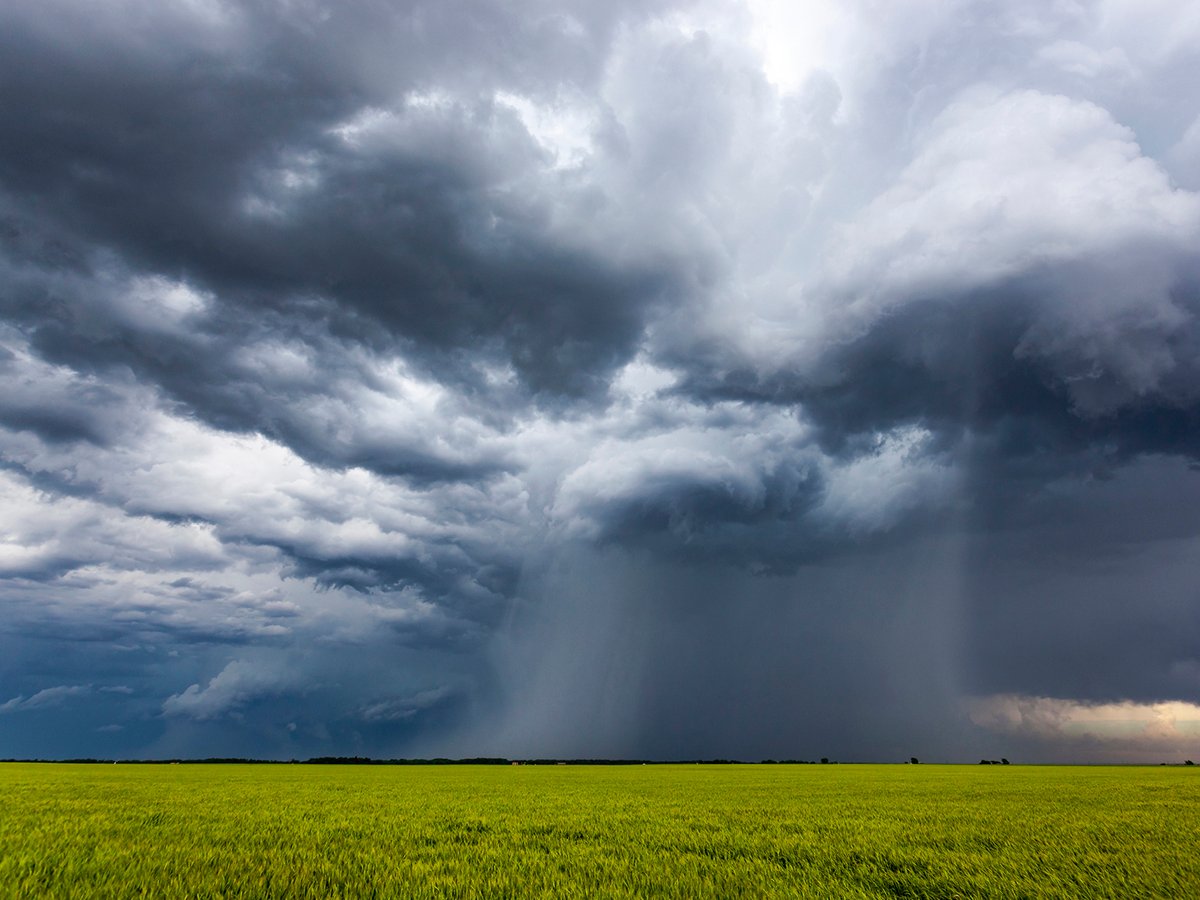On a windy afternoon May 2, Michael Canning of Prairielane Farms near Deleau, Man., was seeding spring wheat into canola stubble.
“We’ve started a bit early this year. We’ve got lighter land out here,” said Canning, who crops about 1,000 acres on a 4,000 acre grain, forage and cattle farm with his father Blaine.
“Barley and oats will be next, then we’ll wait a little while before we put in the canola,” he said, adding that they plan to stick to their rotation, even though canola and wheat prices are looking good.
Read Also

Extreme rain increases as planet warms
In this issue, we are going to wrap up our look at extreme rainfall by examining the different weather patterns that tend to be associated with these rainfall events.
They also keep 280 purebred Black and Red Angus cattle, which will be turned out on pasture within the next two weeks.
Higher fertilizer prices had little effect, mainly because their fields this spring had enough nitrogen from fall-applied manure.
On the same day, east of Souris, Mark Roberts was cultivating dry sloughs and packed runways to aerate the soil ahead of seeding on part of the 3,400 acres that he rents and owns along with his two brothers.
They plan to seed canola and flax on a 50-50 split, with a quarter section of wheat thrown into the mix.
“For the last couple of days we’ve been doing a bit of harrowing,” said Roberts. “I know that guys have been getting out onto the fields early this year, but you know, it’s still only the 2nd of May.”
Soil conditions in the area were dry, but the forecast for the coming weekend was for rain.
“It’d be nice to get some moisture. But maybe it would be good to have the crop in first, then get some moisture,” he said.
Fuel prices haven’t changed their short-term strategy, but long term they are looking at switching to minimum till.
The price outlook for flax looks promising, Roberts said. Canola should be stronger, he added, but local grain buyers aren’t predicting high prices.
The hype about biodiesel pushing oilseed demand higher failed to materialize, said Roberts, who still has last fall’s canola crop in the bin.
“I was holding out for $9 a bushel, but I guess I got too greedy.”
On May 3, Duane Edwards, who farms 6,500 acres with his two brothers on the edge of the Turtle Mountains near Deloraine, was hoping to finish seeding 450 acres of malting barley under contract.
“I’m not sure how it’s going to get sold in the fall,” he said. “I’m not sure if it’s going to be through the CWB (Canadian Wheat Board) or how it will work.”
Barley prices are firming up. He recalled that when he started farming in the late 1970s, barley used to fetch $3 to $4 a bu. Now, decades later, with costs rising across the board, the price is the same.
“It’s a shame to say that 30 years later we’re not getting that much, and in fact, a lot of times we’re getting a third less than that.”
Other crops for Edwards include 2,000 acres of hard wheat, half of which is already in the ground. Last week saw 600 acres of oats seeded and 550 acres of peas.
“They’re a nice crop and finish early in the fall, which gives you some cash flow in August,” he said. “They also leave the land nice for next year. There’s $30 to $35 in nitrogen costs that you don’t have.”
With the ground getting a bit too dry for canola and flax, he was cheered by a forecast predicting up to 20 millimetres (3/4 inch) of rain.
“We could sure use a nice half inch, or more than that,” he said, adding that the dry spring has been a pleasant change after the past few wet years.
Edwards said he and his brothers managed to save almost $60,000 by buying anhydrous ammonia in December. With a well established operation, they have the flexibility to take advantage of out of season prices.
He noted that for all the controversy over the CWB, the spike in fertilizer prices over the winter shows that input volatility has a far greater effect on farmers than the single desk.
“There’s no way the wheat board could have made or lost us $60,000,” he said.
“Nobody’s allowed to put the price of natural gas up for homeowners without going through the utilities board and giving just cause. I’m wondering if we’re going to have to move to that sort of thing with fertilizer.”
Even with higher crop prices this year, by the time many farmers pay for fertilizer and chemicals, they aren’t likely to be much further ahead, he added.
Frank Murray, a farm production adviser based out of the Virden GO Centre, said that seeding is already well underway south of Highway 1, and north of the Trans-Canada, farmers are getting a good start.
On his own 2,000 acre operation south of Macgregor, Man., half had been seeded.
“By this weekend, if we don’t have any more mechanical trouble, we’ll be down to just basically waiting for soybeans and field beans.”
Murray said a number of farmers in his area have planted all their cereals, and are now starting on sunflowers, with beans next on the agenda.
Soil moisture in the area is “pretty decent,” but strong winds over the past few days have not been helping.
“We’re definitely way ahead of normal, but we’d like the wind to go away, and most of us would like a decent rain,” said Murray.
A lot of grumbling has been heard about high fertilizer costs, he added.
“Fertilizer prices have just gotten ridiculous.”














